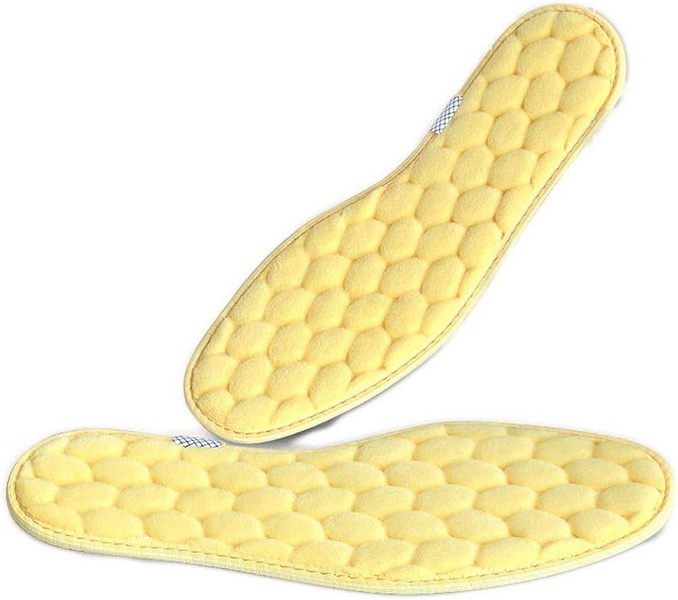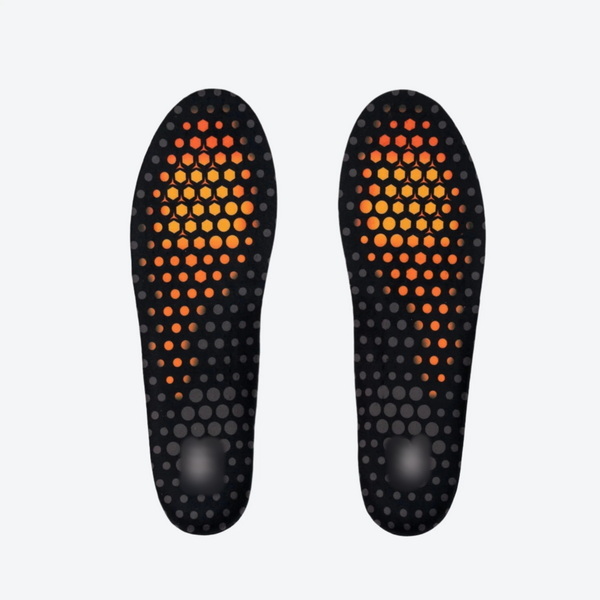










Content Menu
● Introduction to Heated Insoles
● Why Heated Insole Thickness Matters
● Typical Thickness Specifications
● Structure and Materials Impacting Thickness
● OEM Variations and Customization
● Advanced Technology and Material Developments
● Real User Experience with Different Thicknesses
● How to Select the Right Thickness
● Practical Applications and Usage Scenarios
● Durability, Safety, and Maintenance
● Sustainability and Materials Considerations
● Frequently Asked Questions (FAQ)
>> 1. How thick are the average heated insoles?
>> 2. Does a thicker insole always provide more heat or longer battery life?
>> 3. Can heated insoles be trimmed to fit different shoe sizes?
>> 4. Will thicker heated insoles fit in all shoes?
>> 5. What is the recommended thickness for demanding outdoor or industrial use?
Heated insoles, a staple innovation in winter safety and foot comfort, are an essential accessory for anyone working or playing in cold environments. The most frequently asked and crucial question regarding these products is: How thick are heated insoles? Thickness not only affects comfort, but also battery life, fit, heat distribution, and shoe compatibility. Understanding the complete picture ensures successful product selection for brands, wholesalers, and end users alike.

Heated insoles consist of a combination of thermal elements, batteries, durable exterior materials, and advanced ergonomic features. While their main function is to keep feet warm, their structure and comfort are fundamentally influenced by insole thickness and flexibility. In international B2B, knowing the precise technical specs helps buyers select or customize OEM products for specific target markets.
Thickness is not just a technical metric—it is a key factor affecting user experience and product success.
- The thickness impacts how the insole fits inside different shoe types, from snug dress shoes to spacious work boots.
- It dictates battery size, affecting heating duration and overall product weight.
- Excessive thickness may compress foot space and lead to discomfort; insufficient thickness limits battery and insulation options.
- For OEM clients, customizable thickness options allow adaptation for various climates and footwear categories.
A well-designed insole balances thickness, flexibility, and functionality for the widest usability.
Heated insoles come in various thickness profiles. Modern designs utilize advanced materials enabling slim builds without sacrificing battery size or warmth.
For example:
- Standard heated insoles often range between 0.8 cm and 1.8 cm overall thickness, being thicker at the heel for better integration of batteries and insulation.
- Pro or slim models may be as thin as 0.5 cm at the toes, ramping up to 1.2 cm at the heel, to fit snug footwear.
- Entry-level, universal models sometimes offer a more uniform thickness—typically about 1.0 cm throughout.
- Some specialist types, like nanomaterial-based insoles, can reach as thin as 4 mm, enabling use in even tighter shoe spaces.
- More advanced or heavy-duty models for winter boots or industrial PPE may use multilayer structures, up to 1.5–1.8 cm in the heel or arch area.
Variations also exist between brands and markets, so requesting technical data sheets from suppliers is advised for bulk and OEM orders.
Heated insole thickness is determined by several internal layers:
- The uppermost layer is often antibacterial, breathable microfiber or mesh, designed to wick moisture and add softness.
- The heating element sits below, formed either from flexible carbon fiber, graphene film, or safe nichrome wiring. These options influence both the heat profile and insole thickness.
- The mid-layer is dedicated to battery integration, often using lightweight, flat lithium-polymer cells for a low profile.
- Beneath, a layer of shock-absorbing EVA or PU foam provides cushioning and insulation. The density and thickness of this layer are major contributors to overall insole thickness.
- Outsoles or base layers, sometimes cork-infused or rubber-backed, add structural integrity and durability.
Cutting-edge models use graphene heating, providing even heat with minimal bulk, and natural cork for lightweight insulation and adaptability to foot movement.
OEM buyers can request tailored solutions to suit niche requirements:
- For sports, outdoor, or military footwear, thicker insulated layers (up to 1.8 cm) maximize battery capacity and comfort.
- For medical or orthopedic applications, thinner profiles (down to 3–5 mm) support integration into specialized shoes without compromising fit or user mobility.
- Professional customization allows brand-specific adjustments in color, surface texture, battery profile, waterproofing, and even app-based temperature controls.
B2B partners are encouraged to communicate end-user needs clearly. Manufacturers offer both standard SKUs and customizable builds, accommodating geographic and industry-specific needs.
Choosing the right insole thickness is fundamental to product performance:
- Thicker heated insoles excel in situations requiring long warmth and enhanced cushioning, ideally suited for winter boots, mountaineering boots, or PPE.
- Thin heated insoles are optimal for everyday shoes, trainers, or dress footwear, where internal space is more limited.
- A well-matched insole avoids unwanted pressure points or movement inside the shoe, offering support while retaining warmth distribution.
When trimming insoles for size—usually guided by printed outlines—the length can be reduced without affecting the underlying heating layer or altering thickness in key areas (such as the heel or arch where batteries are integrated).
Recent advances have enabled outstanding comfort and performance in extremely thin profiles:
- Graphene heating elements, found in the latest premium insoles, offer superior thermal conduction and flexibility. Graphene's slim structure allows brands to offer models as thin as 3 mm at the forefoot while maintaining high heat efficiency.
- High-density EVA and heat-moldable foam contribute to ergonomic support even in thin builds.
- Some insoles use cork-infused bases, naturally insulating while staying flexible and light—ideal for moisture-prone or rugged outdoor conditions.
- Integration of rechargeable lithium polymer batteries, often with ergonomic curvature, optimizes space without adding bulk.
- Wireless charging, smart mobile controls, and programmable heating cycles represent the latest in user-friendly, space-saving innovation.
Field-tested user reviews highlight the importance of matching thickness to intended application:
- Professional skiers and construction workers often choose thicker soles for battery longevity and comfort despite tighter fit.
- Regular users, preferring discretion and minimal shoe alteration, report high satisfaction with ultra-slim insoles.
- New materials and modular battery designs have addressed early user complaints about bulk and rigidity in heated insoles.
- Trim-to-fit features are highly valued, but only the length (not cross-sectional thickness) is affected by trimming.
When optimizing for business procurement, offering tiered thickness options—such as entry, pro, and performance lines—ensures the broadest appeal and end-customer fit satisfaction.

Selecting the best heated insole thickness is a straightforward but crucial process:
- Start by considering the type of footwear and available internal space.
- For sports, hiking, or work boots, thicknesses of 1.2–1.8 cm at the heel are generally suitable.
- For running shoes and casual footwear, opt for slimline models (as low as 0.5–0.8 cm at the toe and 1.0–1.2 at the heel).
- If long continuous use or extreme cold exposure is expected, prioritize models with more generous padding and bigger battery capacity, accepting the extra height.
- Always trial a sample in the target footwear, particularly for bulk or OEM orders.
- Consider user demographics—some markets prefer subtle insoles for discreet use, while others value additional support and extended battery duration more.
Providing guidance to end users, as well as clear thickness options for distributors and resellers, enhances brand trust and drives successful market entry.
Heated insoles are indispensable in the following settings:
- Outdoor workers (construction, public safety, agriculture) in cold climates benefit from thick, supportive insoles with extended warmth.
- Athletes (skiers, mountaineers, hunters) require models that combine durability, long battery life, and ergonomic fit.
- Medical users, including those with circulation disorders, seek thin insoles for integration into therapeutic footwear with minimal alteration to shoe geometry.
- Everyday urban commuters and fashion-conscious users favor slimline, low-profile heated insoles that fit into dress shoes or sneakers.
Having a broad portfolio of thicknesses ensures suppliers can cater to a full spectrum of B2B and B2C customers.
Durability and safety are key considerations for heated insoless—especially as thickness decreases:
- Thicker insoles often encapsulate heating elements and batteries in protective, shock-absorbing foam, which increases their resilience against bending and impact.
- Modern thin models incorporate advanced waterproof membranes and robust circuits to prevent short-circuiting or sweat damage—essential for long product lifespan and safety compliance.
- Cleaning recommendations differ by model: most models can be wiped clean with a wet cloth; only a few ultra-thin, nanomaterial types tolerate careful hand-washing.
- Battery systems are increasingly safer and more stable, with multi-phase overcharge protection and certified safe materials for skin contact.
Regular inspection and replacement (when foam hardens or batteries degrade over time) ensures both performance and safety.
- Next-gen models prioritize recyclable and non-toxic foams.
- Graphene and cork layers not only enhance function but also improve eco-friendliness.
- Battery modules are getting smaller and greener, reducing environmental impact of spent cells.
- Manufacturers and OEMs increasingly offer take-back or recycling programs for large buyers and institutional clients.
Promoting these aspects gives brands an edge in environmentally conscious global markets.
The thickness of heated insoles is central to their suitability for various shoes, users, and applications. It impacts everything from comfort and heat output to battery performance and shoe compatibility. Modern heated insole technology supports a remarkable diversity, from ultra-thin nanomaterial types (just 3–5 mm) to robust, multi-layered designs up to 1.8 cm thick. Brands and buyers are encouraged to assess their user base, consult with manufacturers, and sample different thickness options to optimize their market entry and user satisfaction. OEM customization remains a key strength, ensuring every sector finds the right balance of warmth, comfort, and safety.

Most models fall between 8 mm and 18 mm in total thickness, typically thinner at the forefoot and thicker at the heel where the battery is located. Specialist models may be as thin as 4 mm, while rugged variants reach up to 18 mm.
Not always. Thicker insoles generally allow larger batteries, which can support higher heat output and longer use. However, the heating element technology, insulation, and electronics efficiency also play a major role in real-world performance.
Yes, most can be trimmed along marked lines to better fit shoe length. This process does not significantly affect the cross-sectional thickness or heating performance, provided trimming is done according to instructions.
No. Thick models may not fit low-volume, narrow, or highly form-fitting shoes such as formal leather shoes or minimalist trainers. Slim models were designed for versatility in such scenarios.
For work boots, hiking, or snow sports, insoles with around 1.2–1.8 cm thickness at the heel are generally recommended due to improved battery capacity and shock absorption.